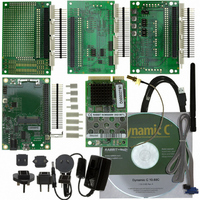101-1285 Rabbit Semiconductor, 101-1285 Datasheet - Page 66

101-1285
Manufacturer Part Number
101-1285
Description
DEV KIT DELUXE MINICORE RCM5600W
Manufacturer
Rabbit Semiconductor
Series
MiniCore™r
Type
Transceiver, 802.11 b/gr
Datasheet
1.101-1285.pdf
(130 pages)
Specifications of 101-1285
Frequency
2.4GHz
Processor To Be Evaluated
Rabbit 5000
Processor Series
RCM5600W
Interface Type
RS-232, USB, PCI
Maximum Operating Temperature
+ 55 C
Minimum Operating Temperature
- 30 C
Operating Supply Voltage
3.15 V to 3.45 V
Silicon Manufacturer
Rabbit Semiconductor
Silicon Family Name
RabbitCore
Kit Contents
Board
Features
On-board Single-Chip 802.11b/g Transceiver, Built-In Web Server
Development Tool Type
Hardware /
Rohs Compliant
Yes
For Use With/related Products
RCM5600W
Lead Free Status / RoHS Status
Not applicable / Not applicable
Other names
316-1161
- Current page: 66 of 130
- Download datasheet (2Mb)
•
60
You do not need to configure the SSID of your network since that is done from the
access point names.
Now configure the access to the two access points.
Modify the access point names and keys to match your access points and network.
WIFIPINGYOU.C
an ad-hoc Wi-Fi network.
This sample program uses some predefined macros. The first macro specifies the
default TCP/IP configuration from the Dynamic C
CONFIG.LIB
Use the next macro unchanged as long as you have only one RCM5600W MiniCore
module. Otherwise use this macro unchanged for the first RabbitCore or MiniCore
module.
Then change the macro to
program on the second RabbitCore or MiniCore module.
The next macros assign an SSID name and a channel number to the Wi-Fi network.
Finally, IP addresses are assigned to the RabbitCore or MiniCore modules.
As long as you have only one RabbitCore or MiniCore module, the Dynamic C
window will display the pings sent out by the module. You may set up a Wi-Fi enabled
laptop with the IP address in
If you have two RabbitCore or MiniCore modules, they will ping each other, and the
Dynamic C
#define IPADDR_1
#define IPADDR_2
// First Access Point
#define AP_0 "test1"
#define AP_0_LEN strlen(AP_0)
#define MY_ADDRESS_0 "10.10.6.250"
#define PING_ADDRESS_0 "10.10.6.1" // address on AP 0 to ping
#define KEY_0 "0123456789abcdef0123456789"
// Second Access Point
#define AP_1 "test2"
#define AP_1_LEN strlen(AP_1)
#define MY_ADDRESS_1 "10.10.0.99"
#define PING_ADDRESS_1 "10.10.0.50"// address on AP 1 to ping
#define KEY_1 "0123456789abcdef0123456789"
#define IFC_WIFI_SSID AP_0
#define _PRIMARY_STATIC_IP MY_ADDRESS_0
#define TCPCONFIG 1
#define NODE 1
#define IFC_WIFI_SSID
#define IFC_WIFI_OWNCHANNEL "5"
STDIO
library.
—sends out a series of pings to a RabbitCore or MiniCore module on
window will display the pings.
"10.10.8.1"
"10.10.8.2"
#define NODE 2
IPADDR_2
"rab-hoc"
to get the pings.
// use this static IP when connected to AP 1
// use this static IP when connected to AP 0
before you compile and run this sample
LIB\Rabbit4000\TCPIP\TCP_
MiniCore RCM5600W
STDIO
Related parts for 101-1285
Image
Part Number
Description
Manufacturer
Datasheet
Request
R

Part Number:
Description:
COMPUTER SNGLBD BL2120 FRCTNLOCK
Manufacturer:
Rabbit Semiconductor
Datasheet:

Part Number:
Description:
KIT APPLCTN RABBITCORE RCM4010
Manufacturer:
Rabbit Semiconductor
Datasheet:

Part Number:
Description:
KIT MESH NETWORK ADD-ON RCM4510W
Manufacturer:
Rabbit Semiconductor
Datasheet:

Part Number:
Description:
KIT DEV FOR BL2500 COYOTE
Manufacturer:
Rabbit Semiconductor
Datasheet:

Part Number:
Description:
KIT APPLICATION SIMPLE SENSOR
Manufacturer:
Rabbit Semiconductor
Datasheet:

Part Number:
Description:
KIT DEV RCM5400W US/INTERNATIONL
Manufacturer:
Rabbit Semiconductor
Datasheet:

Part Number:
Description:
KIT FOR BL4S100 STARTER PACKAGE
Manufacturer:
Rabbit Semiconductor
Datasheet:

Part Number:
Description:
DEV KIT STANDARD MINI RCM5600W
Manufacturer:
Rabbit Semiconductor
Datasheet:

Part Number:
Description:
MODULE RABBITCORE RCM3720
Manufacturer:
Rabbit Semiconductor
Datasheet:

Part Number:
Description:
MODULE RABBITCORE RCM3220
Manufacturer:
Rabbit Semiconductor
Datasheet:

Part Number:
Description:
MODULE RABBITCORE RCM3210
Manufacturer:
Rabbit Semiconductor
Datasheet:

Part Number:
Description:
COMPUTER SGL-BOARD OP6600 W/SRAM
Manufacturer:
Rabbit Semiconductor
Datasheet:

Part Number:
Description:
COMPUTER SGL-BD BL2000 SRAM/FLSH
Manufacturer:
Rabbit Semiconductor











